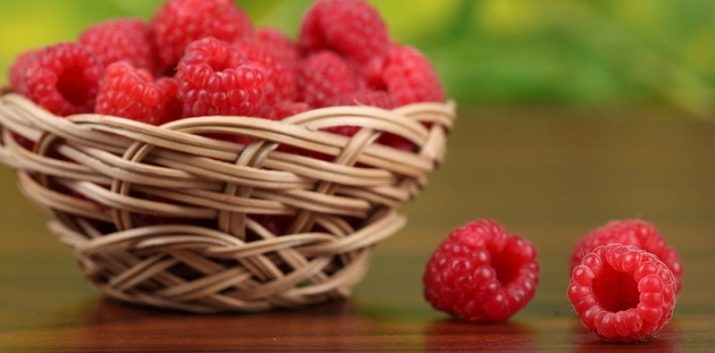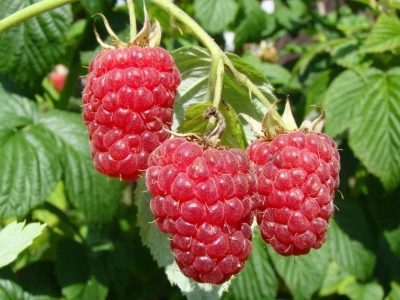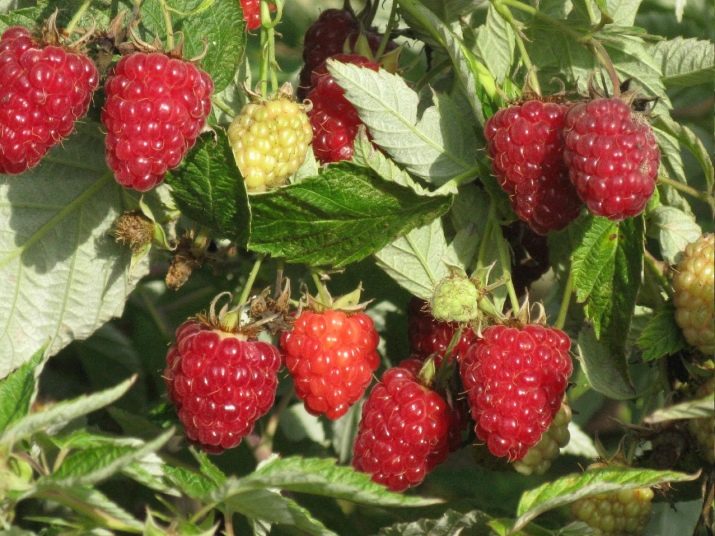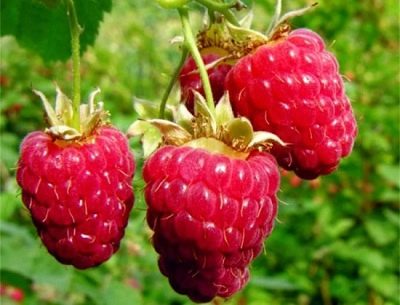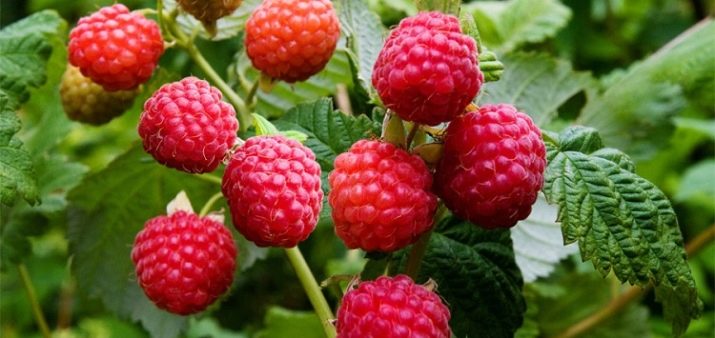How to choose suitable raspberry varieties for different regions?

It is impossible to imagine a country garden or a vegetable garden without raspberry bushes. But many gardeners can be difficult to determine the most appropriate variety of shrubs. This article will discuss in detail all possible options.
Description of the main options
To know which raspberry variety to acquire for planting, you need to understand its forms:
- Large-fruited varieties - the newest ones in breeding; they are distinguished by their fecundity and good quality of berries. Raspberries such varieties most often goes on sale.
- Ordinary (not repair) berry like forest raspberries. With its taste and aroma no other can compare.
- Repair raspberry Loved by many gardeners for an abundance of berries - you can harvest twice a year. Raspberry shtambovyh varieties called raspberry tree. It is little exposed to the diseases of fruits and buds due to their large distance from the earth.
The fruits of each type have their advantages and disadvantages. Therefore, wanting to enrich the garden area with raspberry bushes, the choice of varieties of berries should be approached thoroughly.
Large raspberry varieties
Most often, these varieties are purchased in the hope of a rich harvest. But large-fruited raspberries painfully tolerate lack of care. It requires special conditions: protection from insects and freezing, timely watering, tillage. Otherwise, the plant will get sick, and the bush will have to be removed. Almost all varieties differ in large berries up to 3.5-4 g, and from one bush it is possible to collect up to 2 kg per season.
Popular varieties of large-fruited raspberries:
- "Meteor". Experts call this variety high-yielding. Medium sized fruits have a regular round shape. The pleasant ruby color and rich aroma of the berries makes the variety very popular among gardeners. The first fruits can be collected in June.
- "Lazarevskaya raspberry" different medium-large fruit dull color and elongated shape. Raspberry has a pronounced taste. She endures cold, but is sensitive to raspberry mites.
- Grade "Crane" It is distinguished by the original shape of the berries: the conical fruits of rich red color are easily recognized on the counter.
It is worth noting that in addition to insects and frost, raspberries are afraid of drought. Without getting enough moisture on time, the plant ceases to bear fruit, and then completely dies.
Sweet raspberry varieties
Sweet (or ordinary) raspberries are traditionally considered the most reliable species for planting. It adapts well to environmental conditions, gives a lot of root offspring. Compared with the previous variety, the yield of one bush is weak, and the fruits are almost always small. But at the same time raspberries smell deliciously, and the berries have a deliciously sweet taste. The color of the raspberry can vary from light pink to yellow-orange and even maroon black.
Popular varieties:
- "Early Sweet" differs in rather high semi-sprawling bushes with straight-growing prickly shoots. From one bush it is possible to collect from 1.2 to 1.5 kg of small berries, and their weight rarely reaches 2 g. In addition, they are practically not transportable and look more like forest raspberries.
- "Amateur Sverdlovsk" different bright, juicy berries with a strong aroma. Most gardeners choose this variety for the rapid ripening of berries, resistance to frost and disease. Raspberries easily pick up fungal diseases, but with the help of modern processing this problem is fairly easy to solve.
- Variety "Sun" has high (up to 2 m) and powerful, leaning to the ground shoots. The bushes are lightly studded with thorns, very soft fruits have a strong aroma and sweet-sour taste.
Disease resistant
Very often, raspberries die not from severe frosts or poor care, but from fungal diseases, which are very difficult to remove after a lesion.Today there are special varieties that are not susceptible to disease. Such a breakthrough in modern breeding allowed to bring berries for cultivation in adverse and atypical for these plants conditions.
Types of raspberry, resistant to fungal diseases and insects:
- Variety "Hercules" appeared as a result of crossing two varieties. Frost-resistant large berries of saturated color reach by weight of 2 g. Up to 3 kg of berries can be collected from one bush.
- Grade "Yellow giant" differs in unpretentiousness and will be pleasant to many fans of gardening. Raspberries of this variety are not inferior to other species in taste or aesthetic qualities. Fruits of medium size are rich in honey taste and are more suitable for fresh consumption. When processing and freezing, they quickly lose their shape. Although this taste is preserved.
- Variety "Pride of Russia" considered one of the high-yielding. It is distinguished by unpretentiousness, ease of care, resistance to pests. Shrubs are adapted to severe growing conditions, can tolerate not only severe frosts (up to -27 - 30C), but also drought.
For the middle band
Choosing berries for planting in central Russia, it is important to know some of the features. Berry bushes should be well tolerated by a hot, arid summer and a harsh, cold winter.
Fruiting method
Depending on the type of fruiting distinguish summer and remontant raspberries. In the summer, the development cycle lasts two years: in the first year, flower buds form in the leaf axils, and in the second of them fruit branches grow. The first fruits of the summer raspberry appear in early June, and you can harvest for another 1.5 months.
During the summer, young white shoots (from 3 to 7 cm) with fruit buds grow on additional raspberry roots. They tolerate wintering well and produce flowers and fruits next year. Old shoots of the bush die.
Excellent gardeners received the following crop varieties:
- "Bryansk miracle" It was bred specifically for central Russia. The bushes bear fruit well and give a rich harvest. Fragrant large berries can be collected in the first year after planting. Raspberry withstands frost and drought, but is practically not suitable for transportation: it can be transported only in the first three days after harvesting from the bush. Bushes are littered with small sharp thorns, therefore it is better to pick berries in protective clothing.
- "Early Surprise" differs in bright ruby color of berries. With one bush can collect up to 1.5 kg of berries per season. Raspberry is resistant to almost all fungal diseases.
- "News Kuzmina" different large sweet berries. The bushes bear many fruits, the shape of the berries is oblong with a blunt end, the aroma is not too bright, and the very juicy flesh has a sour-sweet taste. Harvest is easy, because even overripe fruits do not crumble in the hands. But to transport the berries are not suitable. This variety is resistant to frost, but prone to fungal and viral diseases.
Ripening time
The time of ripening raspberries depends on the characteristics of its variety. Early varieties of berries begin to ripen in early June - mid July. The harvest of mid-season varieties of berries begin to collect in the first decade of July. But the berries of late varieties are just beginning to appear in the second decade of July.
Planting raspberries of one variety, the crop is harvested simultaneously from the entire plantation. If you grow plants of different varieties, the timing of the collection of raspberries can vary.
The size and color of berries
Most often, when choosing a variety for purchase, novice gardeners pay attention to the size of the berries. However, the largest raspberry can not always boast juiciness and richness of taste.
There are large and traditional raspberry varieties. Regular berry is not demanding to care, unpretentious and tolerates disease and low temperatures. Despite the fact that such varieties can not boast of large berries, the quality of fruits is high, and their taste is sweet and rich.Krupnosortnaya raspberry received wide popularity for its portability and presentation. Special varieties of berries with sweet taste and large size of fruits were bred.
Raspberries come in several colors. The traditional color of this berry is red. But in fact, raspberry varieties are a huge amount, and almost every one of them differs from the others, if not in color, then at least in shade. Yellow raspberry is not very well known, but in no way inferior to the familiar red berry. The fruit tastes juicy and sweet-sweet. The yield of yellow raspberries is several times less, but in general it is unpretentious and grows throughout the country. The colors of the berries range from bright yellow to almost colorless white.
The rarest raspberry is the rarest. She hails from North America, so for the time being it is not so common in Russian dachas. It is often confused with blackberries, but experts know that blackberries always break along with the white stalk, and at the raspberry it remains on the bush. Black raspberry has bluish bark and original taste.
Standard
Standard raspberry looks like a tree: the largest bushes can reach up to two meters in height. Plants of this species need special care. With the arrival of spring, you should engage in pinching the tops, so that as much as possible the ovary is formed before September. Standard varieties are unpretentious and resistant to most diseases. They tolerate low temperatures well, but need shelter for the winter.
The stems differ from the usual raspberries in that there are no thorns on them, which greatly facilitates picking berries. Such raspberry fruits large sweet fruits. Some varieties are remontant and are able to produce crops twice a year.
Among the specialists are popular varieties such as "Fortress", "Fairy Tale", "Tarusa". The berries of these varieties are well acclimatized across the territory of all of Russia and are distinguished by excellent taste, frost resistance and ease of care.
The best views for the Moscow region
The suburbs are notable for their difficult climatic conditions. Here frosts start early, so for planting it is better to prefer unpretentious raspberry varieties.
Most often in this region, experienced gardeners planted raspberry remontant varieties that easily tolerate frost, is resistant to diseases and bears fruit well. In addition, remontant raspberries will delight the harvest in the first season after planting.
A wide range of modern varieties makes it possible to choose the appropriate view for the cottage or a country house. Observing the rules of cultivation and care, you will surely collect a rich harvest.
Remontnaya
The main difference between reparative raspberries and the usual one is double fruiting per year.
The advantages of raspberry remontnaya:
- stable high yield;
- resistance to pest attacks;
- immunity to disease;
- does not need shelter during the wintering period, as shoots are simply cut off at the end of the season;
- first harvest in the first year of planting;
- no need for a garter or support.
Repair varieties tolerate frost well. Even if the temperature drops too low, and the roots will slightly freeze, a new growth will still appear on the bushes in the spring.
Rating of varieties of repair raspberries:
- "Diamond". Shrubs reach up to 1.5 m in height. The fruiting period begins in early August. Large berries are distinguished by a bright ruby color, excellent transportability and sweet taste.
- Variety "Bryansk divo" It is considered high-yielding: up to 3 kg of raspberries per year can be collected from one bush. The elongated red berries have dense pulp, which simplifies transportation and storage.
- Brusvyana raspberry has large berries. Bushes high, tree. They do not need a garter and begin to bear fruit in the middle of summer.
Early
Early varieties of raspberries begin to bear fruit at the end of May, and in cold terrain the first berries appear in June.Early varieties are characterized by high frost resistance, aroma, rich taste and a less rich crop. But the quality of the berries makes them easy to transport and store.
Popular varieties:
- Variety "Scarlet Sails" produces smaller fruits and does not always please with a bountiful harvest. But dense ruby berries are suitable for sale and for conservation.
- Fruits varieties "Zorenka Alai" gardeners loved for bright scarlet color, rounded shape, pleasant taste and ease of transportation. The berries are not showered, but they hang on the shoots for a long time and are practically not affected by rot and fungus.
- Moscow Giant (Moscow Giant) it stands out among the other varieties with a rich taste and high yield. Bushes can reach up to 2 m in height, the lack of thorns simplifies picking berries. The fruits have a characteristic aroma, sweet taste, juicy and dense flesh. The variety is resistant to frost, but needs shelter.
Late
Late raspberry is no less popular. You can harvest until late autumn. These varieties are especially fond of summer residents, who rarely come to the site.
Popular late varieties include:
- "Indian summer" with large dark red berries of a pleasant taste and aroma. Fruits appear in early June, and for the season you can collect up to 1 kg from a bush.
- "September" raspberries were bred by American breeders and are distinguished by gray shoots and rounded red berries. It tolerates the first frost well, but is prone to disease.
Average ripening
Varieties that have been bearing fruit since mid-summer are traditional varieties of raspberry bushes in Russian cottages. They are characterized by large or medium-large fruits, sweet taste, rich bright color and good transportability. But at the same time, almost all varieties do not tolerate wintering badly and need either pruning or shelter. Experienced gardeners urge not to forget about the prevention and chemical protection of plants.
Ural and Siberia
Ordinary raspberry varieties do not recommend planting in these regions, since the conceived yield and taste of berries depends on the growing conditions of the plants.
What are characterized by
In the summer, it often rains here, which also affects the growth and fruiting of the shoots. And in winter, severe frosts can lead to freezing of branches. It is best to plant a repair raspberry, which tolerates winter well and has two ripening terms.
Siberia is characterized by a short summer, when spring frosts drag on until the beginning of June, and the first frosts come as early as September. For this area are suitable varieties of medium ripening.
What are the
In these regions, the most popular varieties are recognized:
- "Early Sweet"which well tolerates Siberian frosts;
- "Sibisky Light", derived specifically for the area;
- "Reward"resistant to bad weather and frost;
- "Barnaul", with small but tasty fruits.
Most of the early and summer varieties will suit the Urals:
- Kirzhach;
- "Malakhovka";
- "Shy";
- "Gift".

